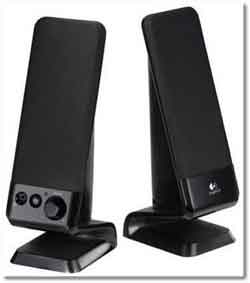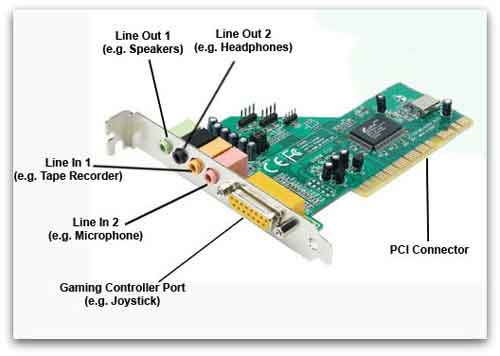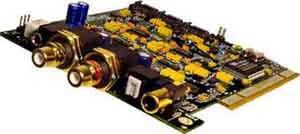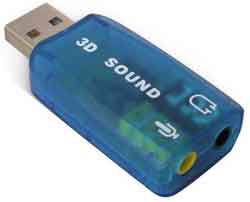- Home
- Computer Basics
- Sound Card Definition
Sound Card Definition | Your Sound Card Introduction
Stephen Harrison B.Sc. (Hons), M.Sc., MBCS, CITP
A Sound Card Definition can vary depending on which website you visit. Audio Cards enable your device to create and play sound! However, there is much more to these cards than you may realize.
They come in different shapes, sizes and capabilities. Some are installed inside your computer and others can be plugged in to the USB port. The quality is constantly evolving, and today we can enjoy 4k audio quality, which is much crisper than those old vinyl records.
In this article, we take a brief look at what a sound card is exactly, then the capabilities of sound cards including what each of the ports are for. We also look at what modern sound cards are used for.
Keep up with the latest news and developments
Sign up to the eComputerZ Newsletter
The free A to Z of performing BIOS updates guide that anyone can follow.
✔ A checklist of important actions to perform throughout the update process.
✔ Further supporting information to aid your update plans.
✔ My unique approach for sourcing the latest BIOS versions for any motherboard manufacturer.
Sign up below for instant access to the guide, or by going to the Subscription page for more details.
I never share information with third parties and your details are secure.
I aim to issue newsletters at the start of each month.
Contents
What is a Sound Card ?
If you take a look at different websites, you'll see different sound card definitions. Here is my attempt at describing what a sound card is.
An audio card is generally described as a type of expansion card (because you are expanding your computer's capabilities) that is capable of receiving and sending audio signals to and from your computing device.
Audio cards are also known by various other names, for example, Audio Adapter, Audio Card and soundboard.
It is a generally a card that slots inside your motherboard's PCI slot inside your computer. It enables you to playback music and record things such as your voice into a microphone.
Sound cards are standard on all modern computers, and they are generally incorporated in to the motherboard. In addition, all laptops and lots of PCs have an internal speaker for audio output.
However, in my experience, internal speakers are low quality. The output can be distorted and difficult to listen to.
All audio cards have the option to plug in external speakers. This can greatly improve the output quality.
 Sound Card Definition Article
Sound Card Definition ArticleExternal Computer Speakers
In addition, you can also adjust the volume on external speakers rather than relying on changing the volume on the operating system.
In my experience, the volume button will trigger a crackling and popping sound when turning the volume up or down, then will be Ok when you reach your desired volume level.
This is usually because of a collection of dust and dirt inside the volume controller. The simple fix is to switch off your speakers and turn the volume button up and down quickly, around 20 times. If you have compressed air, use this on the volume button too.
Switch back on and test. Hopefully, the issue will be rectified.
In the next section of the sound card definition article, we briefly look at the sound card in some more detail.
Return to the Table of Contents
The Anatomy Of A Sound Card
Cheap sound cards come with extra features these days that used to be reserved for expensive sound cards. In addition to a port for a microphone and another for speakers, most audio cards come with a gaming joystick port.
They also come with an auxiliary port for connecting devices such as a hi-fi system, or amplifier. Headphones can also be connected.
The image below is annotated with descriptions of the different sound card ports.
 Sound Card Definition Article
Sound Card Definition ArticleTypical Sound Card Ports
Today, sound cards have evolved to improve both sound quality and choice.
Convenient external sound cards are now available that simply plug in to your USB port. For as little as £5 they include 3D sound, speaker and headphone jacks. Click the image below, and you can buy this from Amazon.
All this means is the quality of the chips on the cards are so advanced they provide industry quality sound. Anything over £300 is aimed at professionals.
 Sound Card Definition Article
Sound Card Definition ArticleThe Expensive But High Quality
Cantatis Overture Sound Card
There are many products on the market that plug into sound cards. For example, products that enable you to convert old vinyl records or tape to MP3.
Modern PCs are colour coordinated to make things easier. Each port will have a colour that closely matches the cable that plugs into it.
Inside your machine, there is an audio cable that connects your CD/DVD drive to your sound card. This is usually the only way your machine can produce the sound from your music CD or film DVD.
A lot of today's computers do not have a PCI sound card plugged into the motherboard. Instead, the audio technology is part of the motherboard. This is known as an integrated sound card. This is also the case for laptops and tablet computers.
The expensive cards have other technologies built in to edit and produce professional quality sound by eliminating noise and improving sound tones.
Return to the Table of Contents
Sound Card Definition | Final Thoughts
It is remarkable to think that before sound cards existed, computers could only make a beep noise!
An integrated card is more than adequate for everyday home users. However, if you need more advanced features, you will have to buy a more expensive card and fit it into your computer.
The integrated card will also need to be disabled on the motherboard. This is done on the computer BIOS.
I hope the sound card definition is clearer to you. Now, it is time for you to take a look at the sound card installation tutorial.
The computer hope site has a good web page on a sound card definition that is worth a read.
- Home
- Computer Basics
- Sound Card Definition

